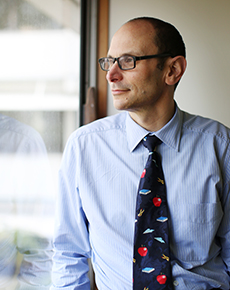New teachers get mindful to cope in the classroom

Teaching is a highly stressful occupation and studies report that in New Zealand 37 per cent of teachers resign by the end of their third year teaching.
AUT education lecturer Dr Ross Bernay decided to address this issue in his doctorate of education (EdD) which looked at whether mindfulness can be used as a coping strategy for new teachers.
What is mindfulness?
A long time practitioner of mindfulness which, he defines as being present and focused in the moment without judgement, Bernay wanted to study its effect in helping beginner primary school teachers meet the demands of the classroom. Mindfulness traces its roots back to Buddhism and can be found in most religions and indigenous traditions but it is not of itself religious, he says.
Bernay says while mindfulness research in education only began 10 years ago, the health sector has recorded a range of benefits of mindfulness for patients over the past 30 years. These include reduced anxiety and emotion regulation noted in reductions in stress-cortisol and a thickening of the prefrontal cortex which is associated with emotion regulation. Research subjects have also have reported improved sleep patterns and improvements in attention and focus.
The research
For his own research Bernay set up a group of five alumni (teaching in early childhood education, primary school, as a relief teacher, in a Montessori unit and at an international school), asked them to keep a journal for a year and interviewed them three times.
“It was a phenomenological study of their first year using mindfulness and there were a lot of open ended questions. I realised it was a lot to ask, given that this was their first year out and they would have a lot of deal with.”
The ‘deliberate’ mindfulness strategies practiced by the participants included: breath awareness, body scan, visualisation, sitting meditation, and growing to understand and employ mindfulness in every moment of their own daily lives.
“Each participant developed their own form of mindfulness practice based on the exercises they were initially shown. Although they were using mindfulness in their everyday activities (gardening, talking to students), several did not engage in formal mindfulness practice until the end of the second term when they felt overwhelmed with stress.”
The findings
Bernay says the study yielded two main findings; that high stress situations prompted the participants to use mindfulness techniques and they were still using them going into their second year of teaching.
“All of the participants were aware that they were ‘noticing’ and observant in the moment. One was pleased with her ability to notice children’s needs and be able to respond. Another noticed that her own body language changed and her muscles tensed when she had to focus on behaviour management instead of her lesson. One participant described her greater efficiency throughout the day because she was mindful in each moment.
“The participants noticed a reduction in stress once they had been engaging in the practice more regularly. More regular practice was evident after the end of term two when each participant was feeling the stress of coping with the demands of the classroom. They were also finding that their lessons were more creative and that they were able to integrate actual mindfulness practices into their teaching.”
One participant spoke of a group of students that was particularly difficult to work with but once she began using mindfulness regularly and to reflect on these students and how she was teaching them, her teaching became more creative and the students more interested in what she was teaching and therefore engaged in learning not misbehaviour.
“In the end as a result of the doctorate I am more committed to having mindfulness as a part of teacher education here and having it as a part of the professional development programme of teachers in the field.”